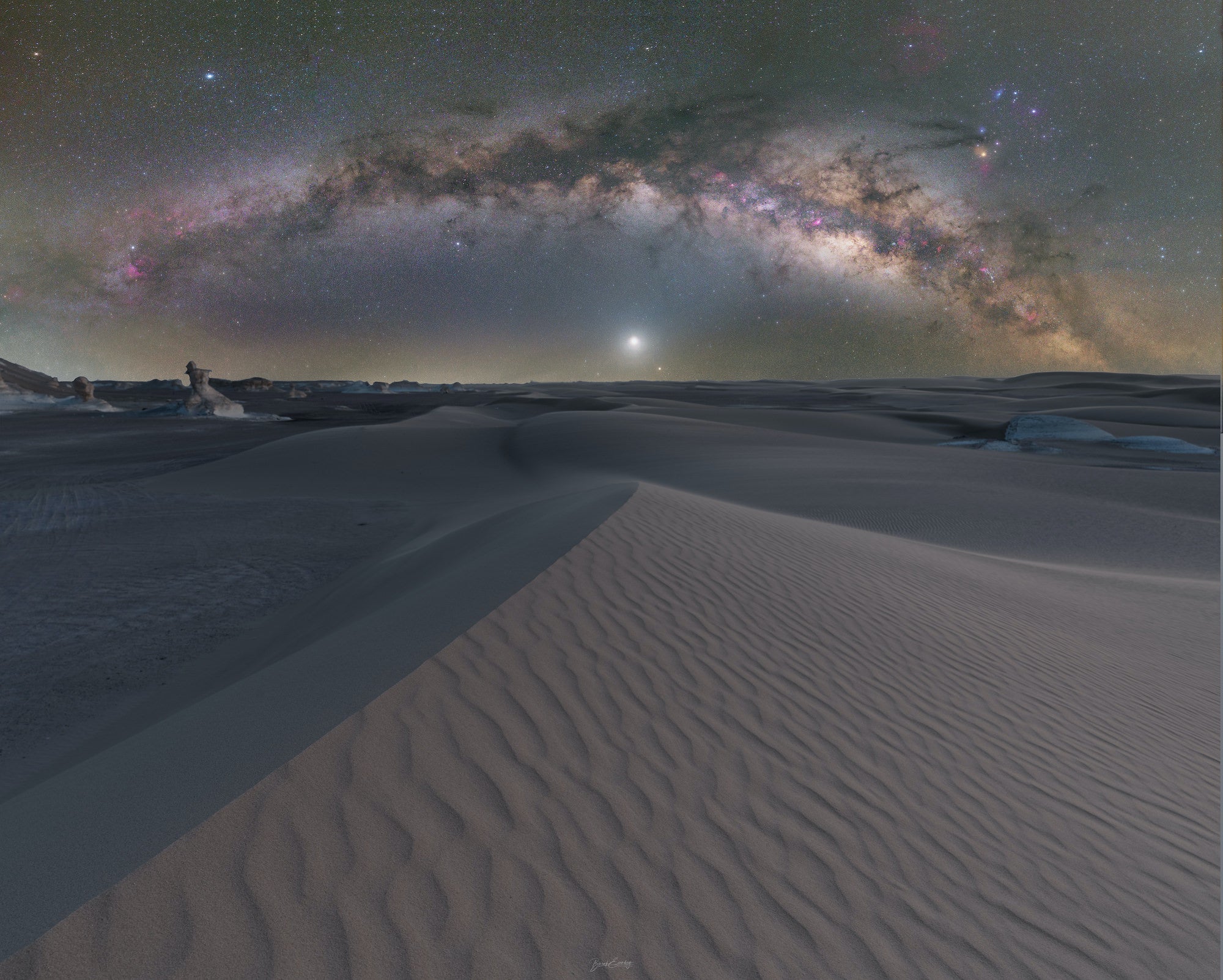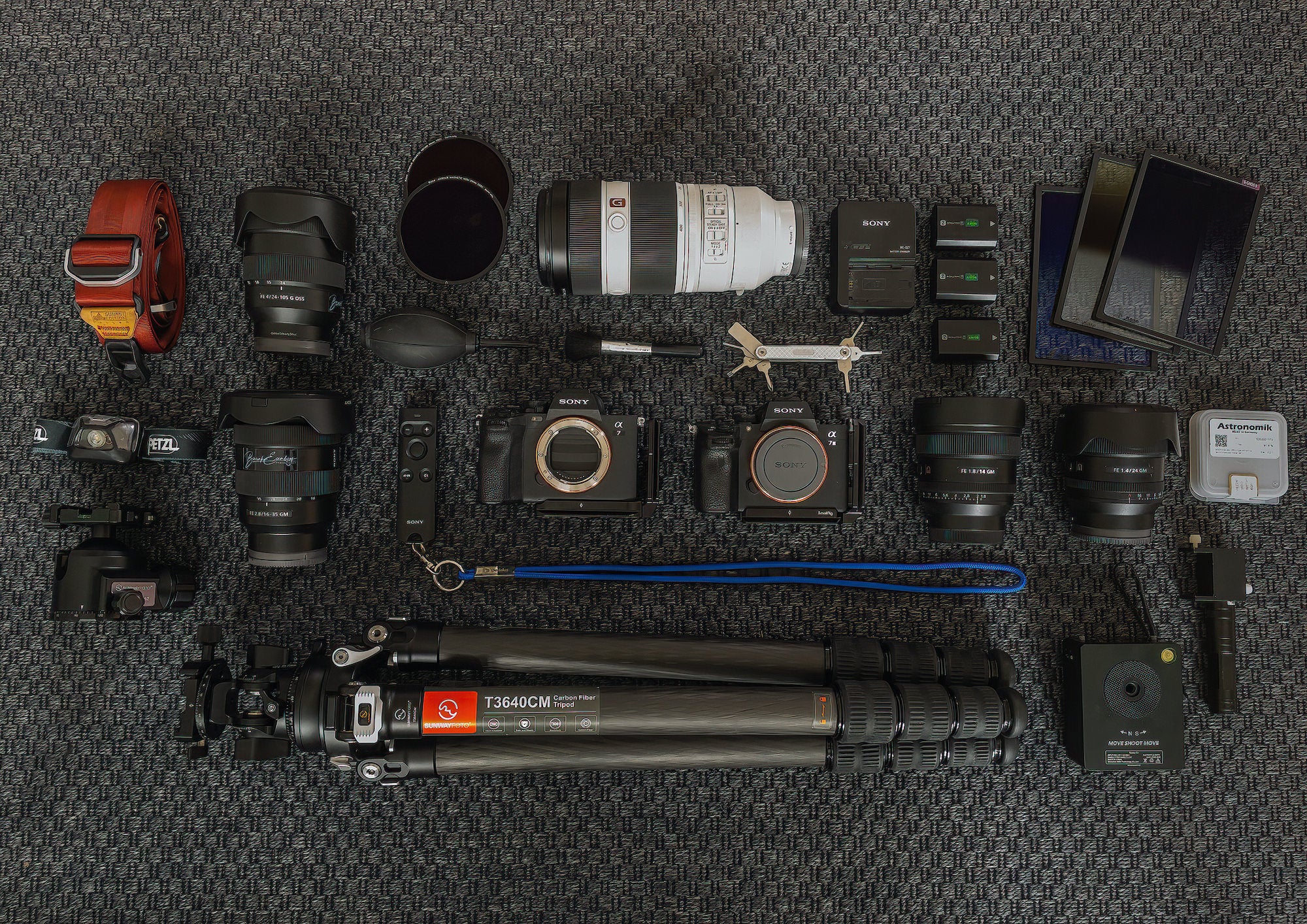Burak Esenbey (@BurakEsenbey) is a professional landscape and astrophotographer who frequently travels to places like Chile, Argentina, Jordan, Egypt, Namibia and Iceland to photograph the natural world. In 2023, he also began offering photo trips to places like Namibia and Turkey. Among his accolades, Esenbey has been honored in competitions including Capture The Atlas: The Milky Way Photographer of the Year '22 + '23, Top 101 at the International Landscape Photographer of the Year, and 2nd place at the 35 Awards in Night Photography. We saw this image, "Dune," when it was honored in the Royal Museums Greenwich - London: Astronomy Photographer of the Year 2023 Competition. From the stunning Milky Way to the interesting foreground elements, it’s easy to see why this image stood out to the judges. We reached out to Esenbey to find out the story behind the shot. Keep reading as he explains how he made this astro-landscape masterpiece by combining images from a pair of Sony Alpha setups cameras and lenses helped him create the image.
Product Preview – In This Article You’ll Find:
–Sony Alpha 7 IV
–Sony Alpha 7S (astro-modified)
–Sony 14mm f/1.8 G Master
–Sony 16-35mm f/1.4 G Master
–Sony 24mm f/1.4 G Master

Photo by Burak Esenbey. Foreground: Sony Alpha 7 IV. Sony 16-35mm f/2.8 G Master. 3 at 13-sec., f/8, ISO 640 Sky: Sony Alpha 7S (astro-modified). Sony 14mm f/1.8 G Master. 5 at 181-sec. tracked, f/2.8, ISO 1000.
Cliffs & Sand Structures In The White Desert
To make this picture we flew with a small group to Egypt to see the “White Desert,” a national park located in the Farafra depression. The park is the site of these large white chalk cliffs, formed by erosion from wind and sand. They create a surreal landscape of extraordinary formations combined with sand structures. There are also cliffs and larger sand dunes, as seen in my picture.
In this region a guide is essential, they are a requirement of the park, and for good reason, as we would not be able to keep track of this huge area. With the group and our two guides, we even spent a full night there. They have set up a kind of camp for us and we had a really exciting time there seeing everything and taking photographs.
Essential Tools For Night Photography
For this trip I had two Sony cameras in my backpack, the Sony Alpha 7S and the Sony Alpha 7 IV. My Sony Alpha 7S was astro-modified to capture even more red colors in camera. That allows me to capture the red nebulae in the Milky Way even better. The Sony cameras are incredible tools for night photography. I am so glad I used them because I knew I wanted to make a surreal photo here and I needed the best gear possible to do so.
When it comes to lenses, on this trip I mainly used the Sony 14mm f/1.8 G Master and the Sony 16-35mm f/2.8 G Master. Recently I fell in love with the Sony 24mm f/1.4 G Master lens, which is a superb lens for the night sky. Its sharpness is unmatched and I love the perspective of the wide angle.

Other essential pieces for creating the image were a sturdy tripod, I use the Sunwayfoto, an intervalometer to set the exposure time longer than 30 seconds, and a Star Tracker, which allows me to work against the earth's rotation when shooting. This means I can take significantly longer shots of the night sky without star trailing.
If you are interested in what else is in my bag, check out my gear article HERE.
Blending Time To Create A Panorama
Normally we spend a significant amount of time preparing for such an image. In this case, however, this was not possible because this region does not have well-known spots, rather we found good locations through our exploration and testing compositions in the foreground. Therefore, we drove through various different areas with the guides until we found suitable photo motifs for us. This spot caught my eye right away because I was specifically looking for such sand dunes. I love this kind of structure in the sand and especially in combination with the night sky, it almost can't go wrong.
Once I checked the alignment of the Milky Way, I set up my tripod and leveled it. A leveled tripod is the basic requirement for panorama shots. Then we waited until darkness set in. Since we got here relatively late, we didn't have to wait long. For the image, I preferred to capture the foreground shots in the late blue hour – a so-called time blending. Of course it would also have been possible to take these pictures during the astronomical night, but for reasons of quality and details I made a different decision here.
I used my Sony Alpha 7 IV for the foreground photos. Obviously there is a difference with the size of the images later when combining foreground and sky, therefore I decreased the foreground image and left the sky as is. This may not be absolutely necessary, but I felt the quality with the Sony Alpha 7 IV would be better for photographing the foreground. My settings for the foreground were 16mm, 3 exposures at 13-sec. each, f/8, ISO 640.
Later, when the Milky Way rose, I set up my tracker. With the tracker, the most important thing is that it is correctly aligned with the Earth's axis. Panorama shots on a tracker are a challenge, because you have to constantly make sure that the camera remains leveled. By rotating the tracker, this is lost and readjustment is necessary. With long exposures like mine, which was at 181 seconds, a readjustment is necessary after each shot. Tracking allows me to decrease the ISO significantly and each frame comes without noticeable noise. Another benefit of tracking is that the f-stop doesn't have to be wide open, it is absolutely fine to close it a bit to get a sharper image. The Sony Alpha 7S and the entire S-Series is a beast in the night and I got five great vertical frames for the panorama. My settings for the sky were 18mm, 5 tracked exposures at 181-sec. each, f/2.8, ISO 1000.
Post-Processing To Bring It All Together
When editing the image, the two panorama lines are first put together. In this case, I did the whole thing in Lightroom, today I would probably work more with PTGui. After the rows of images have been assembled, the individual rows are processed and prepared. I always do the first basic adjustments in Lightroom before I do further steps in Photoshop.
There is not much to say about the foreground, after the first adjustments I did the fine tuning in Photoshop and prepared the picture so that it can be merged with the sky again. Tracked images must always be merged in two steps, because tracking would inevitably blur the foreground.
Editing the sky is more complex. I always start with the reduction of the stars. This is a technique to visibly reduce the multitude of stars. It doesn't remove stars, it just makes them less visible. This is an advantage later on as it will allow the details of the Milky Way to be seen better and not be covered by the glow of the stars. In the second step, the image is stretched in software. Briefly explained, "stretching" is a common technique employed for astrophotography to bring out the details and colors of the Milky Way from the available data in the image files. A big challenge in this step was the bright Venus in the center of the frame. Venus was very prominent in the sky and I really needed to be very careful while editing, because this section was always on the edge of being completely blown out. Last but not least comes the fine tuning with color and contrast. The final step then involves merging the sky and the foreground.
See more of Burak Esenbey’s work on Instagram @BurakEsenbey and at burakesenbey.com.



